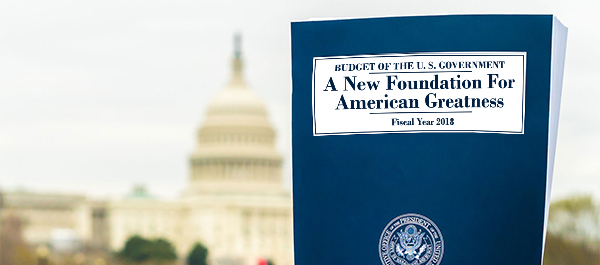Clean Water Current
President’s FY 2018 Budget Proposal Cuts EPA and Related Agencies

The Trump Administration released its full Fiscal Year 2018 (FY18) Budget Proposal May 23, and the Proposal aligns closely with the preliminary FY18 Budget outline released in March—calling for significant cuts to a large number of discretionary non-defense agencies and programs. The largest proposed cuts are to the EPA, which would see a 31% cut in funding and 20% cut in staffing.
By comparison, the U.S. Department of Agriculture would be reduced by 20%. the U.S. Army Corps of Engineers’ budget by 15%, and the U.S. Department of Interior by over 10%.
Despite these drastic cuts to EPA, its Clean Water and Drinking Water State Revolving Funds (SRFs) would receive sustained funding in FY18 (including a $4M increase to the CWSRF relative to FY17). To put that in context, the SRFs capitalization grants constitute a full 40% of the EPA's Proposed Budget. The WIFIA loan program would receive another $20M.
The continued support for the SRFs and WIFIA in a tight budget, bodes well in that the Administration seems to recognize the value that these infrastructure programs provide. This demonstrates that NACWA and the water sector’s message is being heard in terms of funding and we thank all NACWA members who have worked to engage political leaders and share the successes and challenges the water sector faces. This advocacy will continue to be crucial moving forward.
Another rare increase in the proposed budget is for the Office of Information & Regulatory Affairs (OIRA). This relatively small office would receive a 10% funding boost to $11M in FY18. OIRA serves as the EPA's regulatory gatekeeper, reviewing major federal actions. OIRA staff would likely play a major role in advancing regulatory improvement ideas that NACWA has already shared with the Administration.
Of equal concern, however, is the fact that most programs of interest to the municipal clean water community — and the staffing needed to support these programs — would see large proposed cuts or outright elimination, including:
- EPA's Geographic Programs, such as the Great Lakes Restoration Initiative, Puget Sound, and Chesapeake Bay Program, are zeroed out (from $473M in FY17)
- EPA's CWA §319 Nonpoint Grants are zeroed out (from $165M in FY17)
- EPA's Critical Infrastructure Protection Program is zeroed out (providing cybersecurity assistance for utilities - loss of $11M from FY17)
- EPA's CWA §106 Grants to States are reduced 30% (loss of $80M from FY17)
- EPA's Research Budget is reduced 50% (loss of $235M from FY17)
- EPA Enforcement Budget is reduced 20% (loss of $129M from FY17)
- USDA's Rural Water & Wastewater Program is zeroed out (loss of $498M from FY17)
- USDA's Regional Conservation Partnership Program, proposed for elimination after FY18
Each of these programs is vital to NACWA members in unique ways, and may only exacerbate the affordability and compliance challenges that clean water agencies face. For example, the proposed cuts to USDA's Rural Wastewater program would increase demand on the CWSRF. The programmatic cuts would also increase strain on state programs and reduce opportunities for strategic watershed collaboration. EPA's staffing reductions would also have the effect of causing programmatic delays and creating new uncertainty for the regulated community as institutional knowledge is lost and initiatives get shunted to 50 states that may take different approaches.
Attention Shifts to Congress
The President's Budget is typically considered a guidance document for Budget and Appropriations negotiations in Congress, which has the ultimate responsibility of crafting and bringing forward a final spending package for the President's approval. As soon as the FY18 Proposal was released, many Congressional Republicans – not to mention Democrats – objected to many of the proposed cuts, suggesting that the final FY18 spending legislation will look notably different than the Administration’s proposal. In theory, Congress will stay on schedule and complete the FY18 budget, and all 12 appropriations bills by Sept.30. Already last week, Congressional Committees started holding Budget and Appropriations hearings. The Committees have also solicited written testimony regarding FY18 spending, which NACWA provided
However, it seems unlikely that Congress can complete its work by Sept. 30 – with the FY18 Proposal release just last week (rather than February) and the process already several months behind. Further, Congressional leadership has other major legislative priorities– namely tax reform and healthcare repeal – that they hope to address during the process. Thus, FY18 may begin with another continuing resolution or “omnibus bill.”
NACWA will be working alongside other organizations in the water sector to support robust funding for municipal clean water priorities in FY18.
For more information, please contact Kristina Surfus, NACWA Director, Legislative Affairs.